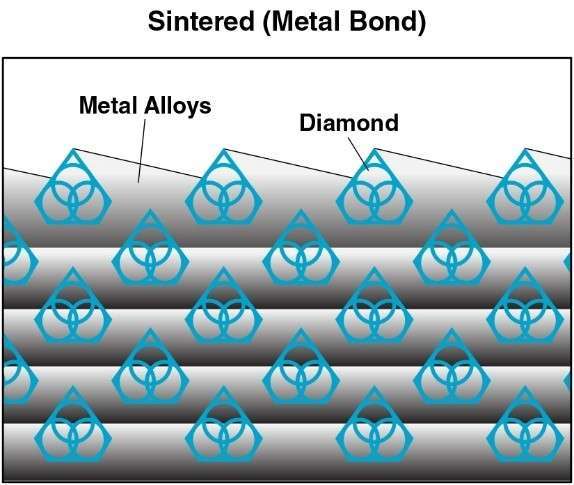Menu
No products in the Quote Basket.
9 am to 6 pm PST time
No products in the Quote Basket.
SMART CUT® (METAL BOND) series New Generation & Technology Dicing Blade are some of the thinnest, universal, and long lasting blades available today. You can't gent more life out of any other blade. Manufactured utilizing SMART CUT® technology, Sintered (Metal Bonded) dicing blades will give you consistent results you can count on everyday.
Sintered (metal bond) Dicing blades have excellent form holding & corner characteristics, provide very long life, high level of consistency. Recommended for users requiring very straight cuts and larger blade exposures. Typical cutting rates of 0.025" on ceramic of .04" per second up to 0.1" per second at 20k RPM, 30 micron grit size, .006" thick
Sintered (Metal bonded) diamond blades diamonds sintered and multiple layers of diamonds impregnated inside the metal matrix. Diamonds are furnaces sintered in a matrix made of iron, cobalt, nickel, bronze, copper, tungsten, alloys of these powders or other metals in various combinations. Metal Bonded Dicing Blades are “impregnated” with diamonds. The compacted materials are then hot pressed or sintered to full density. Heating rate, applied pressure, sintering temperature and holding time, are all controlled according to the matrix composition. This means that selected diamonds are mixed and sintered with specific metal alloys to achieve the best cutting performance possible on any large variety of material. The metal bond surrounding the diamonds must wear away to continuously keep re-exposing the diamonds for the diamond tool to continue cutting.
Manufactured utilizing SMART CUT® technology, each diamond works like a small horse. Diamonds come in contact with the material in the right place and at the right time, working where you need them most. You get the maximum use out of diamond and bond.
Diamonds are oriented inside metal matrix, so that every diamond is better able to participate in cutting action.


The newly exposed diamonds don’t effect diamonds already working on the material. Unlike many other diamond bonds, diamonds in a SMART CUT ® Bond remains sharp and grow sharper with each cut, prolonging product life and consistent performance.

Diamonds or CBN Crystals are activated only at the exposed layer. As Bond Matrix layer begin to wear out, diamonds in a new Bond Matrix layer are immediately activated, substituting the already used up diamond layer. The SMART CUT Diamond Hybrid Bond makes sure every diamond is in the right place and at the right time, working where you need it most.

This advanced formulated open diamond bond design insures minimal chipping, fast cut, constant speed of cut, minimal cutting noise, and most important of all, consistent performance.
Sintered (Metal bonded) diamond blades diamonds sintered and multiple layers of diamonds impregnated inside the metal matrix. Diamonds are furnaces sintered in a matrix made of iron, cobalt, nickel, bronze, copper, tungsten, alloys of these powders or other metals in various combinations. Metal Bonded Dicing Blades are “impregnated” with diamonds. The compacted materials are then hot pressed or sintered to full density. Heating rate, applied pressure, sintering temperature and holding time, are all controlled according to the matrix composition. This means that selected diamonds are mixed and sintered with specific metal alloys to achieve the best cutting performance possible on any large variety of material. The metal bond surrounding the diamonds must wear away to continuously keep re-exposing the diamonds for the diamond tool to continue cutting.


Sintered (metal bonded) dicing blades are recommended for cutting wide variety of materials from 45 to 75 on Rockwell Scale (5 to 9.5 on mohs scale of hardness). It is more wear resistant and holds diamond well in place, usually producing the highest yield/cutting ratio.
As a general rule of thumb, Metal Bond (sintered) diamond dicing blades longer than other diamond bond blades such as resin bond and electroplated (nickel bond) blades.
They wear evenly, and are known for their long life & consistency. Metal bond matrix does not protrude diamonds very high and hence usually requires lower cutting speeds than electroplated (nickel bond) and resin bond blades. In many dicing applications sintered (metal bond) dicing blades are used in applications which are not super hard or super brittle and with minimum tendency to produce chips or cracks.
We will work with you to determine your needs, and recommend the right parameters for your specific material/application. If you are not using SMART CUT® Sintered (Metal Bond) SCM series, you are loosing money & missing out on incredible performance.


Material / Application
Material Abbreviation
SMART CUT™ Blade Series
Diamond Particle Size
Bond Hardness
Diamond Concentration
FIBERGLASS
FGS
SC1M
D126, D107, D91, D76, D54, D46
VVVHB, VVHB, VHBH, HBH, HBM
HIGH CONCENTRATION
CARBON
CN
SC1M
D91, D76, D54, D46, 45µm, 30µm , 15µm
VVVSB, VVSB, VSB
LOW CONCENTRATION
CERAMICS
FRP, CS
SC1M
D54, D46, 45µm, 30µm, 15µm
SBL, MHBL, MHBM
LOW CONCENTRATION
CARBIDE TGC
CE
SC1M
D91, D76, D54.
VVHB, VHBH, HBH, HBM
HIGH CONCENTRATION
QUARTZ
QZ
SC1M
D54, D46, 45µm, 30µm, 15µm
SBL, MHBL, MHBM
LOW CONCENTRATION
OPTICAL GLASS
OG
SC1M
LOW CONCENTRATION
PHOTONICS GLASS
PG
SC1M
LOW CONCENTRATION
MULTI-LAYER CERAMIC CAPACITORS
BGA CSP MLCC
SC1M
30µm, 15µm, 9µm, 6µm, 45µm
LOW CONCENTRATION
THIN FILM DISK DRIVE HEADS, ALUMINUM TITANIUM CARBIDE
PZT; TFDDH
SC1M
D54, D46, 45µm, 30µm, 15µm
LOW CONCENTRATION
SAPPHIRE, AL2O3 +Fe +Ti
SE
SC6M
D54, D46, 45µm, 30µm, 15µm
LOW CONCENTRATION
RUBY AL2O3 + Cr
RY
SC1M
D91, D76, D54, D46, 45µm, 30µm , 15µm
VVVSB, VVSB, VSB
LOW CONCENTRATION
LITHIUM NIOBITE LiNbO3
LN
SC1M
30µm, 15µm, 9µm, 6µm, 45µm
SBL, MHBL, MHBM
LOW CONCENTRATION
LITHIUM TANTILATE LiTaO3
LT
SC1M
30µm, 15µm, 9µm, 6µm, 45µm
SBL, MHBL, MHBM
LOW CONCENTRATION
ALUMINA (HYBRID SUBSTRATES AND CERAMICS PACKAGES
AL
SC1M
D91, D76, D54, D46, 45µm, 30µm , 15µm
VVVSB, VVSB, VSB
LOW CONCENTRATION
QFN, COPPER + EPOXY MOLDING
QFN
SC1M
D126, D107, D91, D76, D54, D46
VVVHB, VVHB, VHBH, HBH, HBM
HIGH CONCENTRATION
ALUMINUM NITRIDE
ALN
SC1M
D91, D76, D54, D46, 45µm, 30µm , 15µm
VVVSB, VVSB, VSB
LOW CONCENTRATION
ZIRCONIA (ZrO2)
ZA
SC1M
D54, D46, 45µm, 30µm, 15µm
SBL, MHBL, MHBM
LOW CONCENTRATION
BORON CARBIDE (B4C)
BC
SC1M
D91, D76, D54, D46, 45µm, 30µm , 15µm
VVVSB, VVSB, VSB
LOW CONCENTRATION
TITANIUM DIBORIDE (TiB2)
TD
SC1M
D91, D76, D54, D46, 45µm, 30µm , 15µm
VVVSB, VVSB, VSB
LOW CONCENTRATION
GLASS + SiO2
GSi
SC6H
30µm, 15µm, 9µm, 6µm, 45µm
SBL, MHBL, MHBM
LOW CONCENTRATION
SILICON
Si
SC1M
D54, D46, 45µm, 30µm, 15µm
SBL, MHBL, MHBM
LOW CONCENTRATION
SILICON-CARBIDE SiC
SC
SC1M
D91, D76, D54, D46, 45µm, 30µm , 15µm
VVVSB, VVSB, VSB
LOW CONCENTRATION
ZINK-SELENIDE ZnSe
ZS
SC1M
VVVSB, VVSB, VSB
LOW CONCENTRATION
BARIUM-TITINATE
BTI
SC1M
VVVSB, VVSB, VSB
LOW CONCENTRATION
BISMUTH-SILICATE Bi12Si22
BS
SC1M
VVVSB, VVSB, VSB
LOW CONCENTRATION
BISMUTH-TELLURIDE
BTE
SC1M
VVVSB, VVSB, VSB
LOW CONCENTRATION
GGGNaGd (W04)2
G2
SC1M
VVVSB, VVSB, VSB
LOW CONCENTRATION
GARNET
G
SC4H
VVVSB, VVSB, VSB
LOW CONCENTRATION
KOVAR NiFeCo
K
SC4M
30µm, 15µm, 9µm, 6µm, 45µm
SBL, MHBL, MHBM
LOW CONCENTRATION
SILICON NITRIDE Si3N4
SN
SC4M
D91, D76, D54, D46, 45µm, 30µm , 15µm
VVVSB, VVSB, VSB
LOW CONCENTRATION
STONE
SE
SC5M
D107, D91, D76.
VVHB, VHBH, HBH, HBM
HIGH CONCENTRATION
NON-FERROUS ABRASION RESISTANT MATERIALS
NFARS
SC6M
D107, D91, D76.
VVHB, VHBH, HBH, HBM
HIGH CONCENTRATION
HIGH SPEED TOOL STEELS
HSTS
SC3M
B126, B107, B91, B76, B54, B46
VVVHB, VVHB, VHBH, HBH, HBM
HIGH CONCENTRATION
DIE STEELS
DS
SC3M
VVVHB, VVHB, VHBH, HBH, HBM
HIGH CONCENTRATION
HARDENED CARBON STEEL
HCS
SC3M
VVVHB, VVHB, VHBH, HBH, HBM
HIGH CONCENTRATION
INCONEL
IL
SC3M
B126, B107, B91, B76, B54, B46
VVVHB, VVHB, VHBH, HBH, HBM
HIGH CONCENTRATION
MONEL
ML
SC3M
B126, B107, B91, B76, B54, B46
VVVHB, VVHB, VHBH, HBH, HBM
HIGH CONCENTRATION
RENE
RE
SC3M
B126, B107, B91, B76, B54, B46
VVVHB, VVHB, VHBH, HBH, HBM
HIGH CONCENTRATION
WASPALLOY
WY
SC3M
B126, B107, B91, B76, B54, B46
VVVHB, VVHB, VHBH, HBH, HBM
HIGH CONCENTRATION
HARD FERROUS SUPERALLOYS
HFS
SC3M
B126, B107, B91, B76, B54, B46
VVVHB, VVHB, VHBH, HBH, HBM
HIGH CONCENTRATION
** Letter Abbreviations: D-FOR DIAMOND, B -FOR CBN.
**** If Material or Application is not listed in the chart above, please inquire. We can provide proper blade specification for just about any type of material/application.





We understand that your success depends on select the right dicing blade, and optimizing your dicing parameters to best fit your applications/needs. The more you understand about what we can do for you, the better our partnership will be. On our website you will find the Most Comprehensive Source of Information on Everything you wanted to know about diamond dicing blades & industrial diamond tools.
Largest Inventory of Precision & Ultra Thin Diamond Dicing Blades in the U.S. Available in different sizes, thickness, arbor sizes, diamond concentrations, diamond mesh sizes, and bond hardness's.
"ONE OF THE MOST EXPERIENCED COMPANIES IN THE INDUSTRY"
Over the years we have enjoyed working with all types if clients, regardless of size. Proprietary dicing blade chemistry, precision manufacturing methods, modern quality control methods, allow us to control and regulate the dozens of variables that affect blade life, quality of cut, surface finish. Reducing and often eliminating additional steps often required after cutting.
We Are a Partner In Your Success
Developing close ties with our customers is the foundation of our business. At the core of
our company is a team of world class engineers, knowledgeable customer service personnel here to serve you. Whether is designing or manufacturing a special solution. We will go out of our way to optimizing your process to ultimate level of efficiency.
American Manufacturer As one of the few remaining independent U.S.Diamond Tool & machine builders. We have the experience & tradition to help you remain at frontier of technology Our experience has been further enhanced by acquiring assets and processes from some of the oldest American tool manufacturers, along with their decades of experience and R& D. This has positioned us as one of the most experienced companies in the industry.
Our unique bond formulations, tool designs, stringent requirements, and utilization of exceptionally high-quality diamonds and raw materials ensure top-notch products that adhere to strict ISO 9000 standards.
Our proprietary technology allow us to control and regulate the dozens of variable that affect toolife, quality, & consistency
Expect More From Your Tools




Signup for email offers, updates, and more

UKAM Industrial Superhard Tools is a U.S. High Technology, Specialty Diamond Tool & Equipment manufacturer. We specialize in producing ultra thin & high precision cutting blades and precision cutting machines diamond drills, diamond micro tools, standard & custom advanced industrial diamond tools and consumables.
Shipping Methods

Safe & Secure Payments

© Copyright 1990-2024. UKAM Industrial Superhard Tools – Terms of Use
No products in the Quote Basket.
No account yet?
Create an AccountSign up to receive exclusive usage recommendations, Illustrated Trouble Shooting Guides & Sales